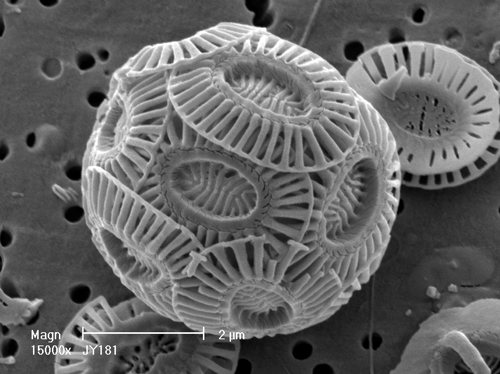To World War II soldiers, “The White Cliffs of Dover” was a morale-boosting song that lifted spirits in dark times. To geographers, the white cliffs mark the point at which England is closest to continental Europe. To scientists, the white cliffs are towering structures made of the chalky, white shells that envelop the single-celled photosynthetic alga known as Emiliania huxleyi. “Ehux” is a coccolithophore, with an exoskeleton made of calcium carbonate. Even though the process by which the alga’s “armor” forms releases carbon dioxide, Ehux can trap as much as 20 percent of organic carbon, derived from CO2, in some marine ecosystems.

Photo: The white cliffs of Dover are composed of the chalky, white shells that envelop the single-celled photosynthetic alga known as Emiliania huxleyi. (Ehux images by Jeremy Young. Background by Caitlin Youngquist, Berkeley Lab)
Ehux and its brethren are the basis of most ocean food chains. Phytoplankton biomass exceeds that of all marine animals combined. Activities of Ehux and some other phytoplankton such as diatoms influence climate processes, such as lowering ocean temperatures by reflecting sunlight and through carbon metabolism. Its versatility in either contributing to primary production of organic compounds from carbon dioxide or adding to CO2 emissions makesEhux a critical player in the marine carbon cycle.Sequenced by the Department of Energy Joint Genome Institute (DOE JGI), the Ehux genome was compared with sequences from other algal isolates and the results reported in theJune 12 edition of Nature.
“Carbon dioxide is fixed during photosynthesis and calcification,” said Betsy Read, a professor of biological sciences at California State University, San Marcos who led the large international consortium of 75 researchers from a dozen nations exploring Ehux and the first author of this paper. “It is also released during the process of calcification, but we do not know how this release balances with the amount of CO2 that is buried when Ehux sinks to the bottom of the ocean. This is an important yet unresolved question.”
Part of the third most abundant group of phytoplankton, behind the diatoms and dinoflagellates, the Ehux strain sequenced by the DOE JGI was isolated from the South Pacific and is the first reference genome for coccolithophores. The project took longer than expected to complete due to the complexities and size of the Ehuxgenome. Originally estimated to be about 30 million bases, closer to a diatom, but the genome ended up being closer to 141 million bases. Starting with an individual investigator working with the DOE JGI for over ten years, the team forged a strong community of users to bring the project to completion.

Photo: Scanning electron micrograph of a single Ehux cell. Ehux is an example of a coccolithophore. (Jeremy Young)
“Because of the size and inherent complexities, the genome become known as ‘The Beast’ and without the epic persistence and unwavering commitment from the DOE JGI, the project would not have been completed,” said Read, who proposed the sequencing of Ehux back in 2002.
With the advent of next generation sequencing technologies the team was able to conduct a comparison of 13 Ehuxstrains revealing the first ever algal ‘pan-genome.” Ehux doesn’t exist as a clearly defined “species” with a uniform genome, but as a more diffuse community of genomes—a “pan-genome”—with different individuals possessing a shared “core” of genes, but supplemented by different gene sets thought to be useful in dealing with the particular challenges of its local environment.
“Ehux thrives in a broad range of physiochemical conditions in the ocean,” ” said Igor Grigoriev, the paper’s senior author, whose team from the DOE JGI led the genome annotation and analysis. “It’s a complex genome, with lots of genes and repeats, the first reference for haptophytes and fills another gap in the Eukaryotic Tree of Life. It is amazing that while you need a microscope in order to see this elegantly sculptured microbe, you can see from outer space the light reflected from large areas of ocean during Ehux blooms.”
The team found variability in the Ehux genome that helps explain the alga’s ability to thrive in oceans from the equator to the subarctic and cause algal blooms in the spring and summer that can cover several hundred thousand square kilometers.

Photo: Phytoplankton bloom in the Barents Sea. The milky blue color is likely caused by E. huxleyi, which can grow abundantly up to 50 meters below the ocean surface. The alga’s blooms tend to be triggered by high light levels during the 24-hour sunlight of Arctic summer. (NASA image courtesy Jeff Schmaltz, MODIS Rapid Response Team at NASA GSFC.)
“Ehux is the dominant bloom forming coccolithophore and is abundant in oligotrophic oceans—those that have little to sustain life—so they exert a large effect on global carbon cycling,” Read and her colleagues wrote. “Until now, the underlying mechanisms for the considerable physiological and morphological variations between isolates have been elusive. Evidence we present indicates that this capacity can be explained in part by its pan-genome, the first of its kind reported for what was thought to be a single microbial eukaryotic algal species.”
The researchers also found that the core gene sets include genes that allow Ehux to thrive in low levels of phosphorus and to assimilate and break down nitrogen-rich compounds. Additionally, the algal genome offers hints that Ehux may be involved in the global sulfur cycle as it is able to produce a compound that can influence cloud formation and therefore climate. The conditions under which Ehux produces the compound and the amounts synthesized are questions the researchers are looking forward to following up on.
“The high diversity within this species indicates that a single strain is unlikely to be typical—or representative of all strains,” the team noted. “Future sequencing of phytoplankton isolates will reveal whether this discovery is a unique or more common feature in microalgae. Together, the physiological capacity and genomic plasticity of E. huxleyimake it a powerful model for studying speciation and adaptations to global climate change.”
Aside from using the DNA to better understand the alga’s role in the planet’s carbon and sulfur cycles, Read and her colleagues see the availability of the Ehux genome sequence as an important first step to unlocking the molecular mechanisms that govern the nucleation, growth, and nanoscale patterning of the calcium carbonate shells. “We have some clues,” she said, “but what makes this more difficult is that proteins involved in calcification are not conserved across biomineralizing species, those that can grow into composite materials. What we desperately need in order to identify the genes is a genetic transformation system. Several labs—including my own—are aggressively working on this.”
Identifying genes and proteins involved in this process, Read added, could lead to the design of new composite materials and devices for applications related to bone replacement, periodontal reconstruction, sensing systems, optoelectronic devices and the treatment of diseases.